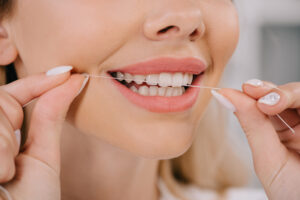You’ve probably been told time and time again that flossing your teeth is important. But is there a right way to floss? why is it so important?
Why you Shouldn’t Skip Flossing in your Oral Hygiene Routine
Flossing is an essential part of oral hygiene. Proper daily flossing is for keeping bad bacteria at bay and preventing gum disease, cavities, halitosis (bad breath), infections, pain in the mouth area, inflammation, and sometimes even developing serious illnesses like diabetes or heart disease later on down the road due to poor dental hygiene overall! Flossing helps physically remove plaque and leftover food particles stuck between your teeth so they don’t become trapped underneath your gums or cause cavities. Unlike brushing, which reaches only some surfaces of the tooth while leaving others hard to clean, flossing gets into all those tight spaces no matter how small they may be. With all this being said, flossing can help you achieve a bright smile- so start getting into that daily routine now so you don’t regret it later! If you are around the Cincy area, learn about our services!
Tips to Flossing

Although it might look as simple as just threading a piece of string between your teeth once or twice a day, there’s actually a more effective way to make sure you’re getting all the areas covered when brushing:
1. Break off about 18 inches of floss and wind most of it around one of your middle fingers. Wind the remaining floss around the same finger of the opposite hand. This finger will take up the floss as it becomes dirty.
2. Hold the floss tightly between your thumbs and forefingers.
3. Guide the floss between your teeth using a gentle rubbing motion. Never snap the floss into the gums.
4. When the floss reaches the gum line, curve it into a C shape against one tooth. Gently slide it into the space between the gum and the tooth.
5. Hold the floss tightly against the tooth. Gently rub the side of the tooth, moving the floss away from the gum with up and down motions. Repeat this method on the rest of your teeth. Don’t forget the back side of your last tooth.
6. Once you’re finished, throw the floss away. A used piece of floss won’t be as effective and could leave bacteria behind in your mouth.
By following these steps correctly every time you brush, and with a valuable nutritional guidance, you’ll be able to effectively get rid of plaque build-up while also massaging your gums so they stay healthy and strong too! contact our office and learn more about taking care of your oral hygiene.


